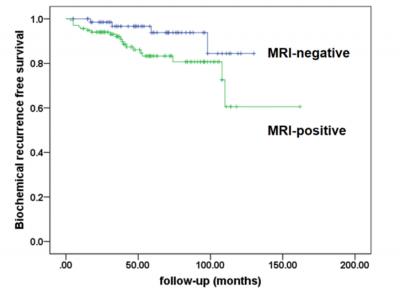|
Cancer - Prostate(구연)
|
(E-111)
|
|
|
글리슨 점수 6점의 중간위험도 전립선암의 잠재적 예후인자에 대한 연구 |
| 분당서울대학교병원 비뇨의학과교실 |
| 노진, 오종진, 안형우, 황성일, 이학종, 송상헌, 김학주, 홍성규 |
Abstract
Background
To identify potential prognostic factors among patients with favorable intermediate risk prostate cancer with a biopsy Gleason score 6.
Patients and Methods
From 2003 to 2019, favorable intermediate risk patients who underwent radical prostatectomy were included in this study. All patients were evaluated preoperatively with MRI. Using PIRADS scores, patients were divided into two groups, and clinic-pathological outcomes were compared. The impact of preoperative factors on significant pathologic Gleason score upgrading (≥4+3) and biochemical recurrence were assessed via multivariate analysis. Subgroup analysis was performed in patients with PIRADS ≤ 2.
Results
Among the 239 patients, 116 (48.5%) were MRI-negative (PIRADS ≤ 3) and 123 (51.5%) were MRI-positive (PIRADS >3). Six patients in the MRI-negative group (5.2%) were characterized as requiring significant pathologic Gleason score upgrading compared with 34 patients (27.6%) in the MRI-positive group (p<0.001). PIRADS score was shown to be a significant predictor of significant pathologic Gleason score upgrading (OR=6.246, p<0.001) and biochemical recurrence (HR=2.595, p=0.043). 10-years biochemical recurrence-free survival was estimated to be 84.4% and 72.6% in the MRI-negative and MRI-positive groups (p=0.035). In the 79 patients with PIRADS ≤ 2, tumor length in biopsy cores was identified as a significant predictor of pathologic Gleason score (OR=11.336, p=0.014).
Conclusions
Among the patients with favorable intermediate risk prostate cancer with a biopsy Gleason score 6, preoperative MRI was capable of predicting significant pathologic Gleason score upgrading and biochemical recurrence. Especially, the patients with PIRADS ≤ 2 and low biopsy tumor length could be a potential candidate to active surveillance.
|
 |
|
keywords : prostate cancer, intermediate risk group, MRI |
|

